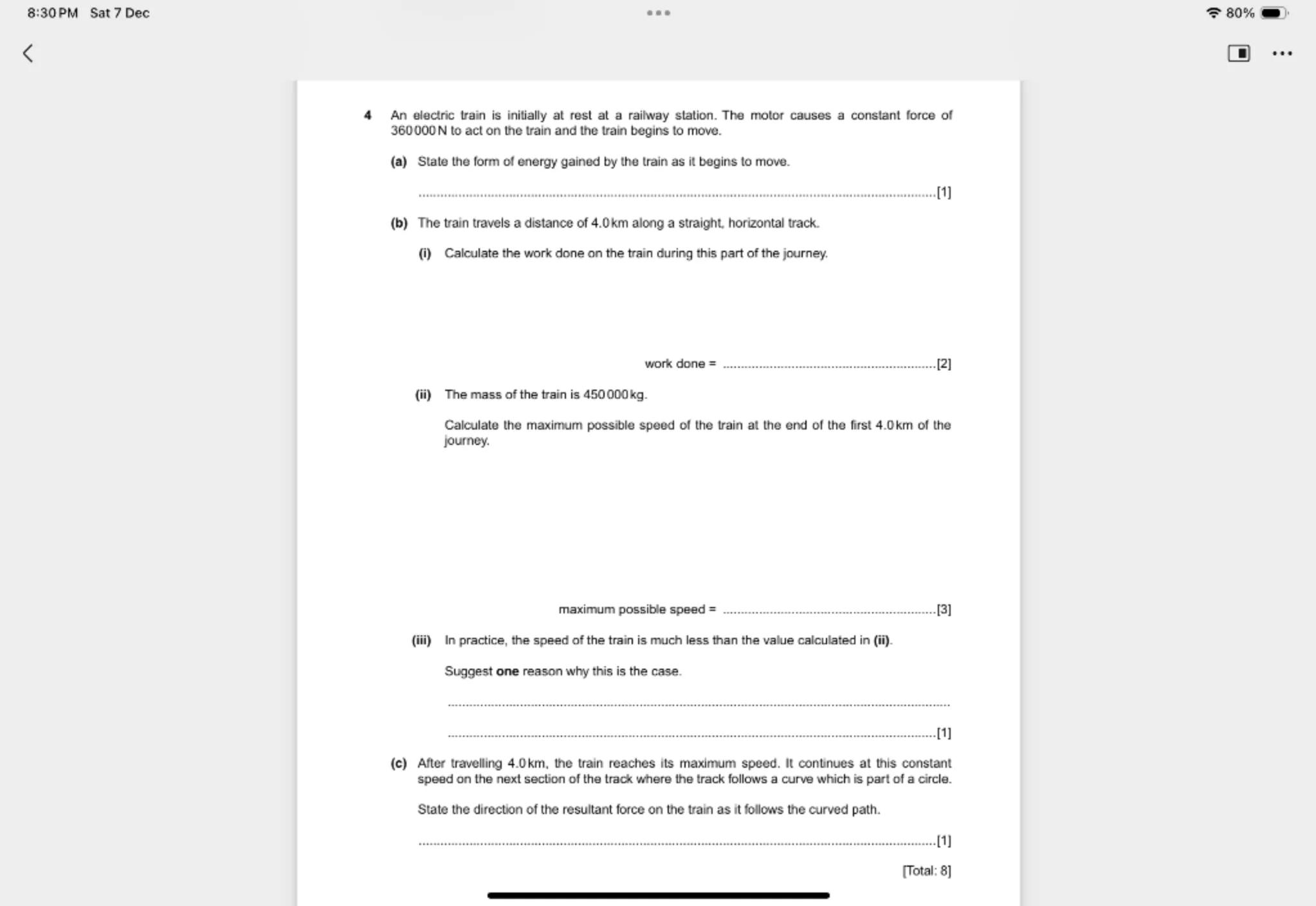
Sia
8:30 PM Sat 7 Dec
4 An electric train is initially at rest at a railway station. The motor causes a constant force of 360000 N to act on the train and the train begins to move.
(a) State the form of energy gained by the train as it begins to move.
[1]
(b) The train travels a distance of 4.0 km along a straight, horizontal track.
(i) Calculate the work done on the train during this part of the journey.
work done
[2]
(ii) The mass of the train is 450000 kg .
Calculate the maximum possible speed of the train at the end of the first 4.0 km of the journey.
maximum possible speed [3]
(iii) In practice, the speed of the train is much less than the value calculated in (ii).
Suggest one reason why this is the case.
(c) After travelling 4.0 km , the train reaches its maximum speed. It continues at this constant speed on the next section of the track where the track follows a curve which is part of a circle. State the direction of the resultant force on the train as it follows the curved path.
[1]
[Total: 8]

Answer from Sia
Posted 12 months ago
Solution
a
The form of energy gained by the train as it begins to move is kinetic energy. This is because kinetic energy is the energy of motion, and as the train accelerates, it gains this form of energy
b(i)
To calculate the work done on the train during the journey, we use the formula for work: , where and \(d = 4.0 \, \text{km} = 4000 \, \text{m}$$. Thus, $$W = 360000 \, \text{N} \times 4000 \, \text{m} = 1440000000 \, \text{J}$$
b(ii)
To find the maximum possible speed of the train, we can use the work-energy theorem, which states that the work done on the train equals the change in kinetic energy: . Rearranging gives us
b(iii)
One reason why the actual speed of the train is less than the calculated maximum speed is due to energy losses from friction and air resistance, which dissipate some of the energy that would otherwise contribute to the train's speed
c
The direction of the resultant force on the train as it follows the curved path is towards the center of the curve. This is because, in circular motion, the centripetal force acts inward, keeping the train on its curved path
Answer
(a) Kinetic Energy
(b(i)) 1440000000 J (b(ii)) 7.75 m/s
(b(iii)) Energy losses due to friction and air resistance (c) Towards the center of the curve
Key Concept
Work-Energy Theorem: The work done on an object equals the change in its kinetic energy. Equation: . Kinetic Energy: . Centripetal Force: .
Explanation
The train gains kinetic energy as it accelerates, and the work done on it can be calculated using the force and distance. The maximum speed is derived from the work-energy theorem, and the resultant force during circular motion is directed towards the center of the curve.
\)Not the question you are looking for? Ask here!
Enter question by text
Enter question by image
Unlock Smarter Learning with AskSia Super!
Join Super, our all-in-one AI solution that can greatly improve your learning efficiency.
30% higher accuracy than GPT-4o
Entire learning journey support
The most student-friendly features
Study Other Question
